,
This year, 2007, marks Tapissary’s 30th anniversary. To celebrate, I’ve been making adjustments to the grammar. The journal is my practice sheet where I merge linguistic invention with my daily experiences.
MINI LESSONS Starting Oct 2 2007, I'm including occasional brief lessons in Tapissary on the Journal. They use the vocabulary and grammar from highlighted journal entries so that you can get more insight into how the sentences work. There will also be a dictionary of the most common çelloglyphs on this site so that you can write your own texts.
There are two different approaches to writing Tapissary. The first, ‘line Tapissary’ (or linear Tapissary) has a grammar that is very close to English. The second, ‘cyclic Tapissary’ involves a grammar that reveals the position of any given communication within the bounds of cycles. Unless otherwise noted, the mini lessons will begin in line Tapissary, which is more basic.
Hansel and Grethel: I am currently translating the Grimm's fairy tale of Hansel and Grethel in parallel text from English to Tapissary. Each day I will post one paragrpah on these journal pages. With the information from the mini lessons, and the notes following each translation, you will be able to use this story as a first reader. Paragraphs 1 thru 16 are written in the linear form of Tapissary which is very easy to compare with English. Starting with paragraph 17, I'm experimenting with a new form of the cyclic grammar. The çelloglyphs are the same, so you can still follow along. The word order and declensions as seen in the transliterations below each Tapissed text will be explained at a later date.
The formulae you see preceding phrases, such as [=] +/\, refer to the cyclic grammar. They explain how the grammar tags onto the cyclic meaning of the sentence.
Beginning with paragraph 21 on Nov 4, I’m introducing the back and forth writing system (called boustrophedon) which is the usual way to read and write Tapissary. I will only use the most common backward çelloglyphs in the Hansel and Grethel story. The backward çelloglyphs are color coded. While reading the transliteration, you will be able to identify the vocabulary by matching its color. The long introductory çelloglyphs are called the warp, and I have rendered them in red. The çelloglyphs that are pinned into the long warps are called weft, and they are drawn in purple. The rest of the text is in black pencil, as usual. I’m using color and directional arrows as training wheels to show the direction that the lines are to be read.
.
.
tapissed entries
,
Nov 4 2007
HANSEL AND GRETHEL
paragraph 21
,
1. [=] +| And early in the morning, before they awoke, she went up to them,
2. + ∆ and saw how lovingly they lay sleeping, with their chubby red cheeks,
3. +| and she mumbled to herself, [≠] +/\ "That will be a good bite."
4. [=] +/\ Then she took up Hansel with her rough hands,
5. +/\ and shut him up in a little cage with a lattice-door;
6. +/\ and although he screamed loudly [≠] +__ it was of no use.
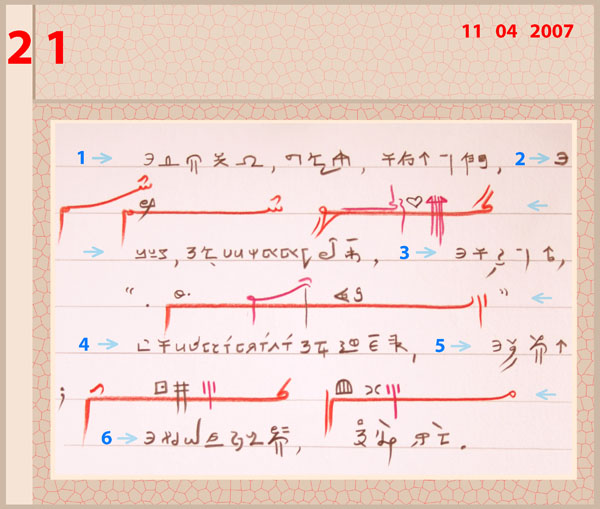
Transliteration
1. And early in ta morning, before they awoke, she went up to them,
2. and saw how lovingly they lay they sleeping, with their chubby red cheeghk,
3. and she meemble to herself, “A good bite thajand get.”
4. Then she Hansendele with her rough haghnd take,
5. and hüm shut up in a little cage with a lattice door;
6. and although he did loudly scream, no nonuse got nonit.
,
,
Nov 3 2007
HANSEL AND GRETHEL
paragraph 20
1. [=] +/\ The old woman behaved very kindly to them,
2. + /\ but in reality she was a wicked witch who waylaid children,
3. +/\ and built the bread-house in order to entice them in,
4. +/\ but as soon as they were in her power she killed them,
5. +/\ cooked and ate them, and made a great festival of the day.
6. +| Witches have red eyes, and cannot see very far; but they have a fine sense of smelling,
7. like wild beasts, +/\ so that they know when children approach them.
8. +/\ When Hansel and Grethel came near the witch's house she laughed wickedly, saying,
9. +/\ "Here come two [≠] +/\ who shall not escape me."
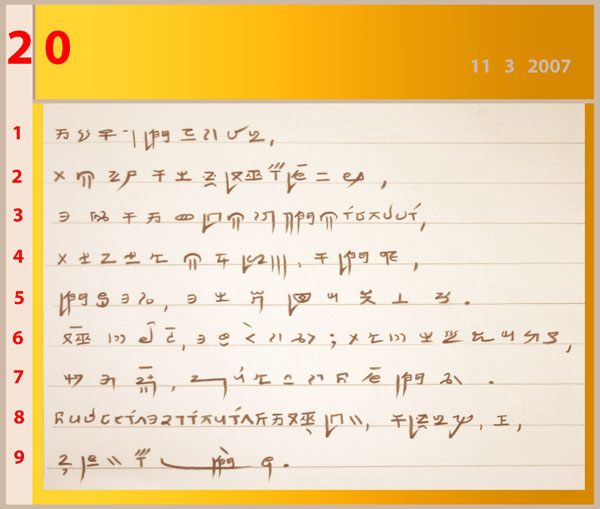
Transliteration
1. S’old woman to thëm behave very kindly,
2. but in reality she a wicked winditche who childrendene waylay,
3. and build she se bread smandaze in order etthem in entice,
4. but as soon as they in her powendere be, she thëm kill,
5. thëm cook and eat, and a great festivandale yta day make.
6. Wightch have red eghye, and can sees very far; but they have a fine sense ysmelling,
7. like wild beaghst, so that they do know when children them approach.
8. When Hansel and Grethel near se witchin smandaze come, she wickedlyndye laugh, saying,
9. Two htar come who I thejems escape.
.
.
Nov 2 2007
HANSEL AND GRETHEL
paragraph 19
,
1. [=] +/\ Just then the door opened, and a very old woman, walking upon crutches, came out.
2. +<> Hansel and Grethel were so frightened that they let fall what they had in their hands;
3. +∆ but the old woman, nodding her head, said, +∆ "Ah, you dear children,
4. what has brought you here? Come in and stop with me, [≠] +__ and no harm shall befall you";
5. [=] +/\ and so saying she took them both by the hand, and led them into her cottage.
6. +∆ A good meal of milk and pancakes, with sugar, apples, and nuts, was spread on the table,
7. +∆ and in the back room were two nice little beds, covered with white,
8. +/\ where Hansel and Grethel laid themselves down, +<> and thought themselves in heaven.
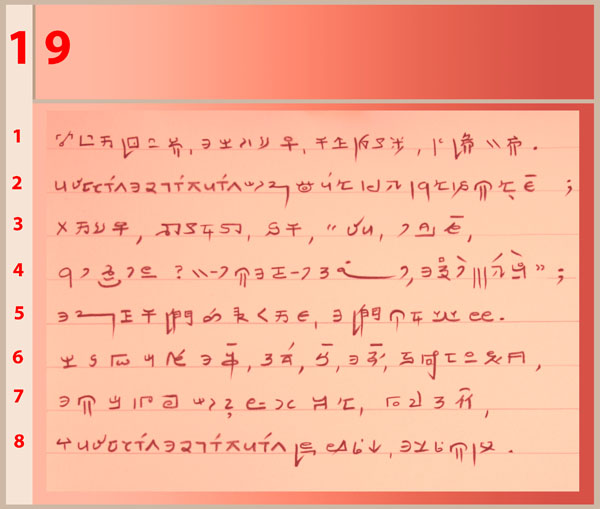
Transliteration
1. Just then se candapis do open, and a very old woman, she upon crutcheing walk, from insindidy come out.
2. Hansel and Grethel were so frighten that they let fall whand they had in their haghnd;
3. but s’old woman, nodding her head, said she, “Ah, you dear children,
4. what you bristing you here? Come d'you in and stop d'you with me you, and no nonyou befajall nonharm”;
5. and so saying she thëm both take by se hand, and thëm into her cottage lead.
6. A good meal ymilk and paghncake, with sugar, aghpple, and nught, was spread it on ge table,
7. and in the back room were 2 nice little bed they, covered with white,
8. where Hansel and Grethel thûrre lay themselves down, and thought themselves in heavene.
,
,
Nov 1 2007
HANSEL AND GRETHEL
paragraph 18
,
1. "We will go in there," said Hansel, "and have a glorious feast.
2. I will eat a piece of the roof, and you can eat the window. Will they not be sweet?"
3. So Hansel reached up and broke a piece off the roof, in order to see how it tasted,
4. while Grethel stepped up to the window and began to bite it.
5. Then a sweet voice called out in the room, "Tip-tap, tip-tap, who raps at my door?"
6. and the children answered, "the wind, the wind, the child of heaven";
7. and they went on eating without interruption.
8. Hansel thought the roof tasted very nice, so he tore off a great piece;
9. while Grethel broke a large round pane out of the window, and sat down quite contentedly.
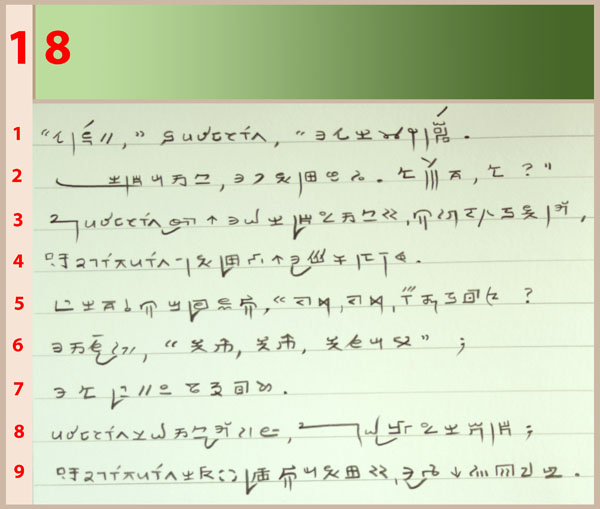
Transliteration
1. [=] +/\ We thejerre go,” said Hansel, “and we a glorious feajeaste.
2. +/\ I a pijice yse roof, and you ge windowe can eat. +∆ They bejes sweet, they?”
3. +/\ So Hansel rüch up and he a pindice off ge roof break, [≠] +<> in order eessee how was la tastle,
4. [=] +/\ while Grethel to ge windindowe step up and began she wis ibbite.
5. +/\ Then a sweet voice in the endexeter call out, “Tip-tap, tip-tap, who at my cahapis rap?
6. and se children aenswer, “ta wind, ta wind, ta child yheaven”;
7. +/\ and they thindisse go on eating without interruption.
8. +∆ Hansel thought he se roof tâste very nice, +<> so he tër off a great pice;
9. +/\ while Grethel a large round pandanne out yge window break, and sat down quite contentedly.
,
,
Oct 31 2007
HANSEL AND GRETHEL
paragraph 17
,
1. It was now the third morning since they had left their father's house, and they still walked on;
2. but they only got deeper and deeper into the wood,
3. and Hansel saw that if help did not come very soon they would die of hunger.
4. At about noonday they saw a beautiful snow-white bird sitting upon a bough,
5. which sang so sweetly that they stood still and listened to it.
6. It soon ceased, and spreading its wings flew off;
7. and they followed it until it arrived at a cottage, upon the roof of which it perched;
8. and when they went close up to it they saw that the cottage was made of bread and cakes,
9. and the window-panes were of clear sugar.
.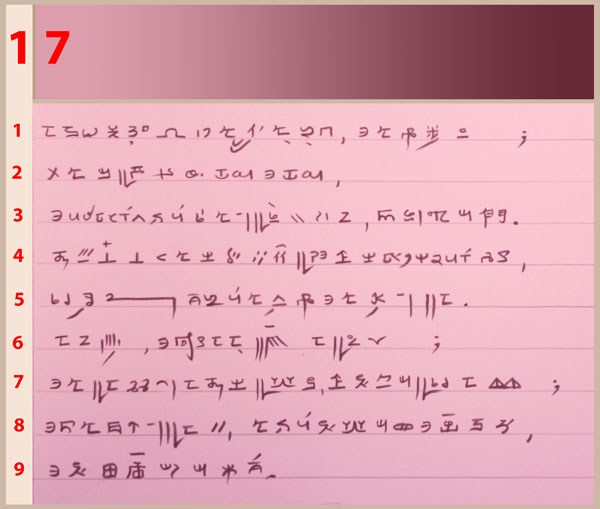
Transliteration:
1. [=] + | It was now ta third morning since they leandreave their fatherin house, and they still waelk on;
2. + /\ but they the woondoode only get deeper and deeper,
3.[≠] + /\ and Hansel saw that if they to hendelpes come very soon, hunger would die of them.
4. [=] + /\ At about noonday see they a beautiful snow-white bindirde upon a boughe sitting,
5. which sang so sweetly + <> that they stood still and they lûsten to wis.
6. +/\ It soon cüse, and spreading it its wighnge it ondoffe fly;
7. + /\ and they windis follow until it at a cottaggende arrive, upon ge roof ywhindiche it perch:
8. + /\ and when they close up to windis go, +| they saw that ge cottage ybread and caghke was make,
9. +| and ge window-paghne were yclear sugar.
Paragraph 17 continues the translations of Hansel and Grethel, only now the style is in Tapissary's cyclic grammar. I decided to switch tracks, because today is Halloween, which just happens to coincide with some new ideas I've been having for the cyclic grammar. This, then, is my equivalent of a bag of treats... linguistic candy. Hope a happy Halloween every ohonne have!
l
l
l
.[][][][][][][][][][][][][][][][][][][][][][][][]
.


